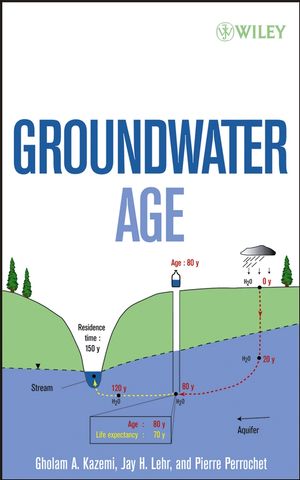Groundwater AgeISBN: 978-0-471-71819-2
Hardcover
346 pages
June 2006
 This is a Print-on-Demand title. It will be printed specifically to fill your order. Please allow an additional 10-15 days delivery time. The book is not returnable.
|
||||||
Preface.
Acknowledgments.
Chapter 1. Introduction.
1.1 Age and lifetime.
1.2 Age determination in geology (Geochronology) and in other disciplines.
1.2.1 Absolute age and relative age.
1.2.2 Determination of absolute age of rocks.
1.2.3 Geological time table.
1.3 Groundwater age and groundwater residence time.
1.3.1 Young, old and very old groundwaters.
1.3.2 Dead water and active water.
1.3.3 Age gradient.
1.3.4 Age mass.
1.3.5 Mixing, dispersion and transport of groundwater age, mean age and distribution of ages.
1.3.6 Average residence time of water in various compartments of the hydrologic cycle .
1.3.7 Hydrogeochronolgy, interdisciplinary groundwater age science and hydrologic time concept.
1.3.8 Event markers.
1.4 Life expectancy.
1.5 Isochrone and life expectancy maps.
1.6 Some groundwater age related terms.
1.6.1 Isotopic age, radiometric age and decay age.
1.6.2 Hydraulic age.
1.6.3 Piston-flow age, streamtube age and advective age .
1.6.4 Model age and apparent age.
1.6.5 Storage time, mean transit time, turn over time, flushing time and travel time.
1.6.6 Reservoir theory and its relation with groundwater residence time.
Chapter 2. History of groundwater age dating research.
2.1 Pioneer of Groundwater Age discipline-sequence of the earliest publications.
2.2 Laboratories worldwide for dating groundwater samples.
2.3 Major contributors to Groundwater Age dating discipline.
2.4 Names familiar in the Groundwater Dating business.
2.5 Important publications.
2.5.1 Book chapters.
2.5.2 PhD and MSc theses.
2.5.3 Journals.
2.5.4 Reports (mainly by the USGS) .
2.6 Aquifers subjected to extensive dating studies.
Chapter 3. The applications of groundwater age data.
3.1 Renewability of the groundwater reservoirs.
3.2 An effective communication tool for scientists and managers- and curiosity to laymen as well.
3.3 Age monitoring for the prevention of over exploitation and contamination of aquifers.
3.4 Estimation of the recharge rate.
3.5 Calculation of the groundwater flow velocity.
3.6 Identification of the groundwater flow paths.
3.7 Assessing the rates of groundwater and contaminants transport through aquitards.
3.8 Constraining the parameters of groundwater flow and transports models (estimation of large scale flow and transport properties).
3.9 Identification of the mixing between different end members.
3.10 Study of the pre-Holocene (late Pleistocene) climate.
3.11 Evaluation of the groundwater pollution.
3.12 Calculation of the travel time of the groundwater plume to the points of interest.
3.13 Mapping vulnerability of the shallow aquifers.
3.14 Performance assessments for radioactive waste disposal facilities.
3.15 Site specific applications.
3.15.1 Identification of the seawater level fluctuations.
3.15.2 Calculating the timescale of seawater intrusion.
3.15.3 Disposal of wastes into the deep old saline groundwater systems.
3.15.4 Management of the dryland salinity in Australia



